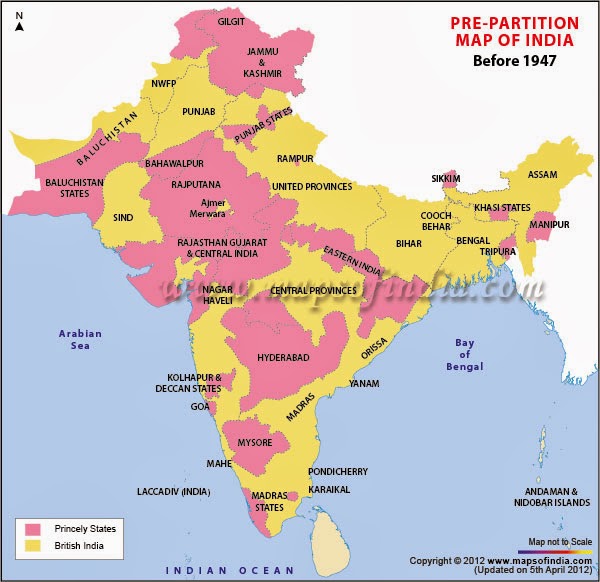Map

Source: eoearth
Himalayan River System VS Peninsular River system
| Perennial; receive water both from Himalayan glaciers and rainfall | Seasonal; dependent on monsoonrainfall |
Antecedent * with dendritic pattern. These rivers are older than Himalayas.
| Super imposed radial and rectangular patterns |
Long course, flowing through the rugged mountains experiencing head ward erosion and river capturing*
| Smaller, fixed course with well-adjusted Valleys. |
| Very large basins | Relatively smaller basin |
| Young and youthful, active and deepening in the valleys | Old rivers with graded profile |
Indus River System
The Indus originates in the northern slopes of the Kailash range in Tibet near Lake Manasarovar. It follows a north-westerly course through Tibet. It enters Indian Territory in Jammu and Kashmir. It has a large number of tributaries in both India and Pakistan and has a total length of about 2897 km from the source to the point near Karachi where it falls into the Arabian Sea. The main tributaries of the Indus in India areJhelum, Chenab, Ravi, Beas and Sutlej. It covers J&K, Punjab and Himachal states of India
Brahmaputra River System
The Brahmaputra originates in the Mansarovar Lake, also the source of the Indus and the Satluj. It flows eastward, parallel to the Himalayas. Reaching Namcha Barwa , it takes a U-turn around it and enters India in Arunachal Pradesh and known as Dihang. The undercutting done by this river is of the order of 5500 metres. In India, it flows through Arunachal Pradesh and Assam, and is joined by several tributaries.

Source: Wikimedia
Ganga River System
The Ganga (Ganges) rises from the Gangotri Glacier in the Garhwal Himalayas under the name of Bhagirathi. This main stream of the river flows through the Himalayas till another two streams – theMandakini and the Alaknanda – join it at Dev Prayag, the point of confluence. The combined stream is then known as the Ganga. The main tributaries of the Ganga are Yamuna, Ram Ganga, Gomati, Ghaghara,Son, Damodar and SaptKosi. The river after traversing a distance of 2525 kms from its source meets the Bay of Bengal at Ganga Sagar in West Bengal.
Yamuna River System

Source: Wikimedia
The River Yamuna originates from the Yamunotri glacier in Uttarakhand. The catchment of the river extends to states of Uttar Pradesh, Himachal Pradesh, Haryana, Rajasthan and Madhya Pradesh and the entire union territory of Delhi. The river flows 1367 km from here to its confluence with the River Ganga at Allahabad. The main tributaries joining the river include the Hindon, Chambal, Sind, Betwa and Ken.
Narmada River System
The Narmada is a river in central India. It forms the traditional boundary between North India and South India, and is a total of 1,289 km long. Of the major rivers of peninsular India, only the Narmada, the Tapti and the Mahi run from east to west. It rises on the summit of Amarkantak Hill in Madhya Pradesh state which form the head of the Satpura Range and pursues a direct westerly course to the Gulf of Cambay. Its total length through the states of Madhya Pradesh, Maharashtra, and Gujarat amounts to 1312 kilometres (815 miles), and it empties into the Arabian Sea in Gujarat.
Tapti River System
The Tapti is a river of central India. It is one of the major rivers of peninsular India with the length of around 724 km; it runs from east to west. It rises in the Eastern Satpura Range of southern Madhya Pradesh state, and flows westward. It flows through Maharashtra’s historic Khandesh and east Vidarbharegions in the northwest corner of the Deccan Plateau and South Gujarat before emptying into the Gulf of Cambay of the Arabian Sea, in the State of Gujarat.
The Western Ghats or Sahyadri range starts south of the Tapti River near the border of Gujarat and Maharashtra. The principal tributaries of Tapi River are Purna River, Girna River, Panzara River, Waghur River, Bori River and Aner River.
Mahanadi River System

Source: Wikimedia
The Mahanadi River system is the third largest in the peninsula of India and the largest river of Orissa state. The basin extends over a vast area and has a total length of 851 km and an annual runoff. The river begins in the Baster hills of Madhya Pradesh flows over different geological formations of Eastern Ghats and adjacent areas and joins the Bay of Bengal after divided into different branches in the deltaic area. The main branches of River Mahanadi meet Bay of Bengal at Paradip and Nuagarh (Devi estuary).
Godavari River System

The river with second longest course within India, Godavari is often referred to as the Vriddh (Old) Ganga or the Dakshin (South) Ganga. It rises at Trimbakeshwar, near Nasik and Mumbai in Maharashtra around 380 km distance from the Arabian Sea, but flows southeast across south-central India through the states of Madhya Pradesh, Karnataka, Orissa and Andhra Pradesh, and empties into the Bay of Bengal. The river splits into two streams in AP thus forming a very fertile delta. Some of its tributaries include Indravati River, Manjira, Bindusara and Sabari.
Krishna River System
The Krishna is one of the longest rivers of India (about 1300 km in length). It originates at Mahabaleswar in Maharashtra and meets the sea in the Bay of Bengal at Hamasaladeevi in Andhra Pradesh. The Krishna River flows through the states of Maharashtra, Karnataka and Andhra Pradesh. Its most important tributary is the Tungabhadra River, which itself is formed by the Tunga and Bhadra rivers that originate in the Western Ghats. Other tributaries include the Koyna, Bhima, Mallaprabha, Ghataprabha, Yerla, Warna,Dindi, Musi and Dudhganga rivers.
Cauveri River System
The Cauveri is one of the great rivers of India and is considered sacred by the Hindus. The headwaters are in the Western Ghats range of Karnataka state, and flows from Karnataka through Tamil Nadu. It empties into the Bay of Bengal.It has many tributaries includingShimsha, Hemavati, Arkavathy, Kapila, Honnuhole,Lakshmana Tirtha, Kabini, Lokapavani, Bhavani,Noyyal and Famous Amaravati.













.jpg)











